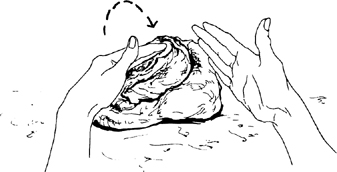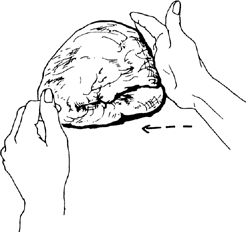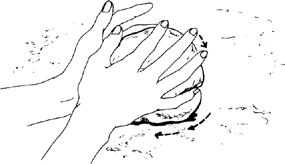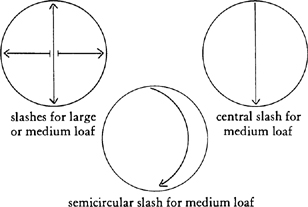Mastering the Art of French Cooking, Volume 2 (31 page)
Read Mastering the Art of French Cooking, Volume 2 Online
Authors: Julia Child

VARIATIONS
Other Forms for French Bread
Long thin loaves
(
ficelles, baked size: 12 to 16 by 1½ inches
)
Cut the original dough,
Step 5
, into 5 or 6 pieces and form as illustrated in the recipe, but making thinner sausage shapes about ½ inch in diameter. When they have risen, slash as illustrated, Step 9.
Oval rolls
(
petits pains, tire-bouchons
)
Cut the dough into 10 or 12 pieces and form like
bâtards
, but you will probably not have to lengthen them at all after the two foldings and sealings. When they have risen, make either 2 parallel slashes, or a single slash going from one end to the other.
Round loaves
(
pain de ménage, miches, boules
)
When you want bread for big sandwiches or for toast, a big round loaf is attractive. The object here is to force the cloak of coagulated gluten to hold the ball of dough in shape: the first movement will make a cushion; the second will seal and round the ball, establishing surface tension. To begin the process, after the risen dough has been cut and has rested 5 minutes,
Step 5
, place it on a lightly floured surface.
Lift the left side of the dough with the side of your left hand and bring it down almost to the other side |
|
| Scoop up that side and |
Then turn the dough smooth side up and |
|
Place the dough pucker side up on flour-rubbed canvas; seal the pucker by pinching with your fingers. Flour lightly, cover loosely, and let rise to almost triple its size. After unmolding upside down on the baking sheet, slash it as follows:
| Large loaves are usually slashed in a cross: make one vertical slash and complete the horizontal cuts as illustrated. Medium loaves may have a cross, a single central slash, or a semicircular slash around half the circumference |
Round rolls
(
petits pains, champignons
)
Cut the original dough,
Step 5
, into 10 to 12 pieces. After they have rested 5 minutes, form them one at a time, leaving the rest of the dough covered. The principles are the same here as for the preceding round loaves, but make the preliminary cushion shape with your fingers rather than the palms of your hands.





